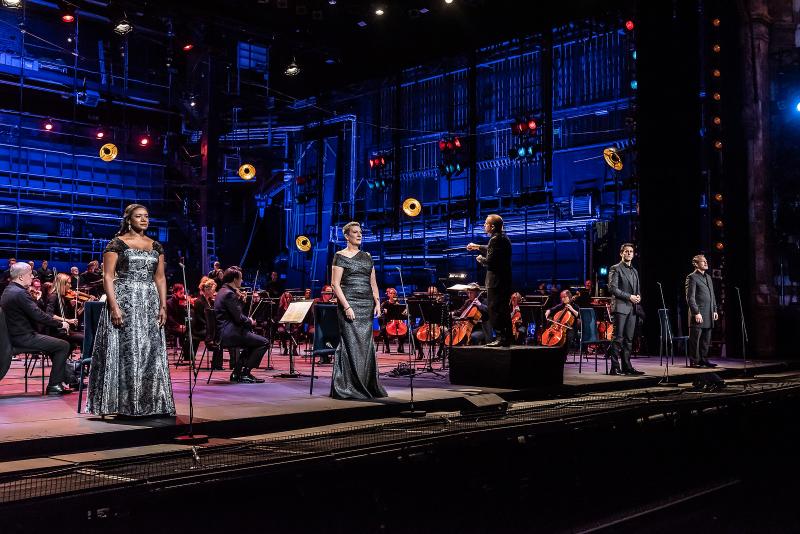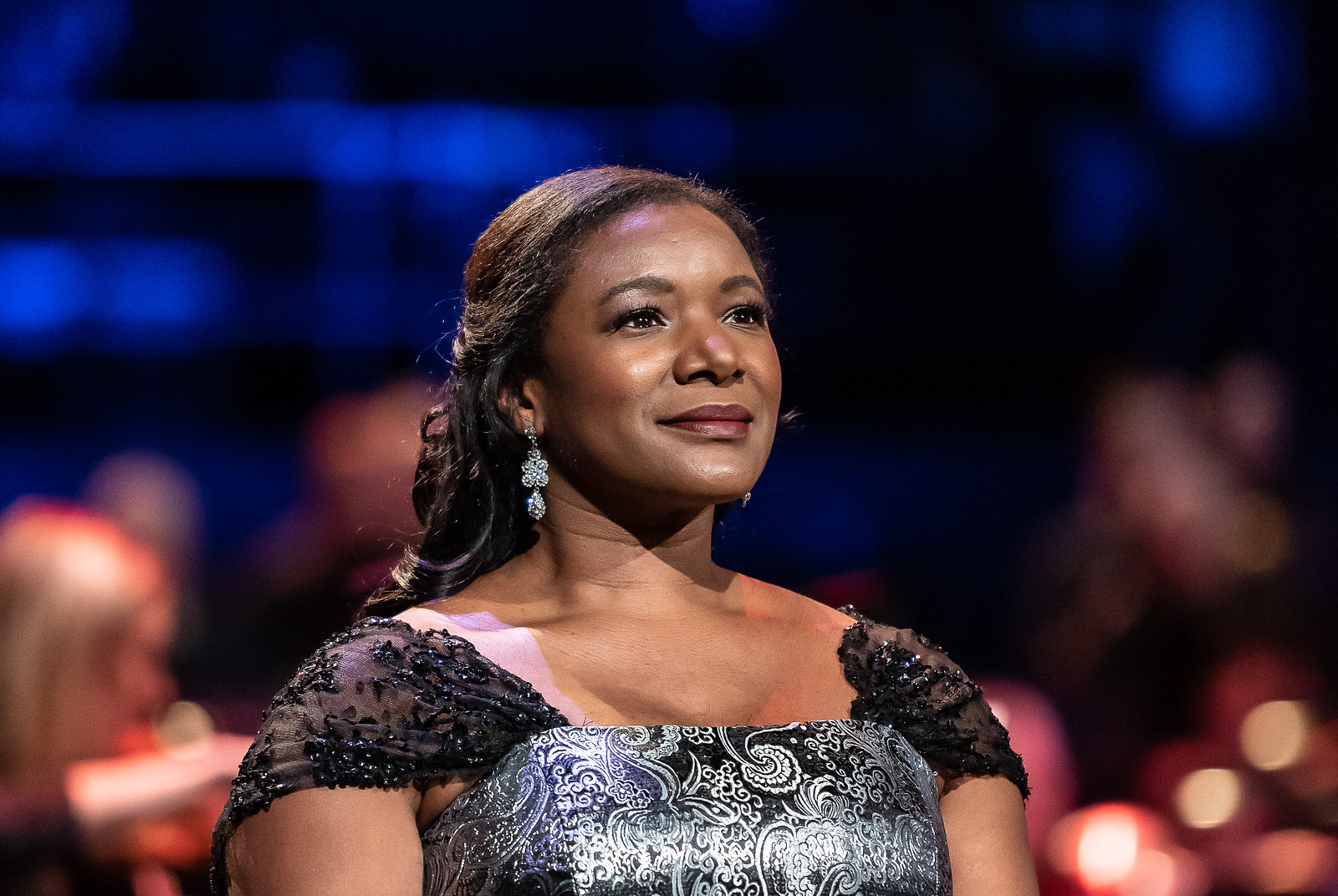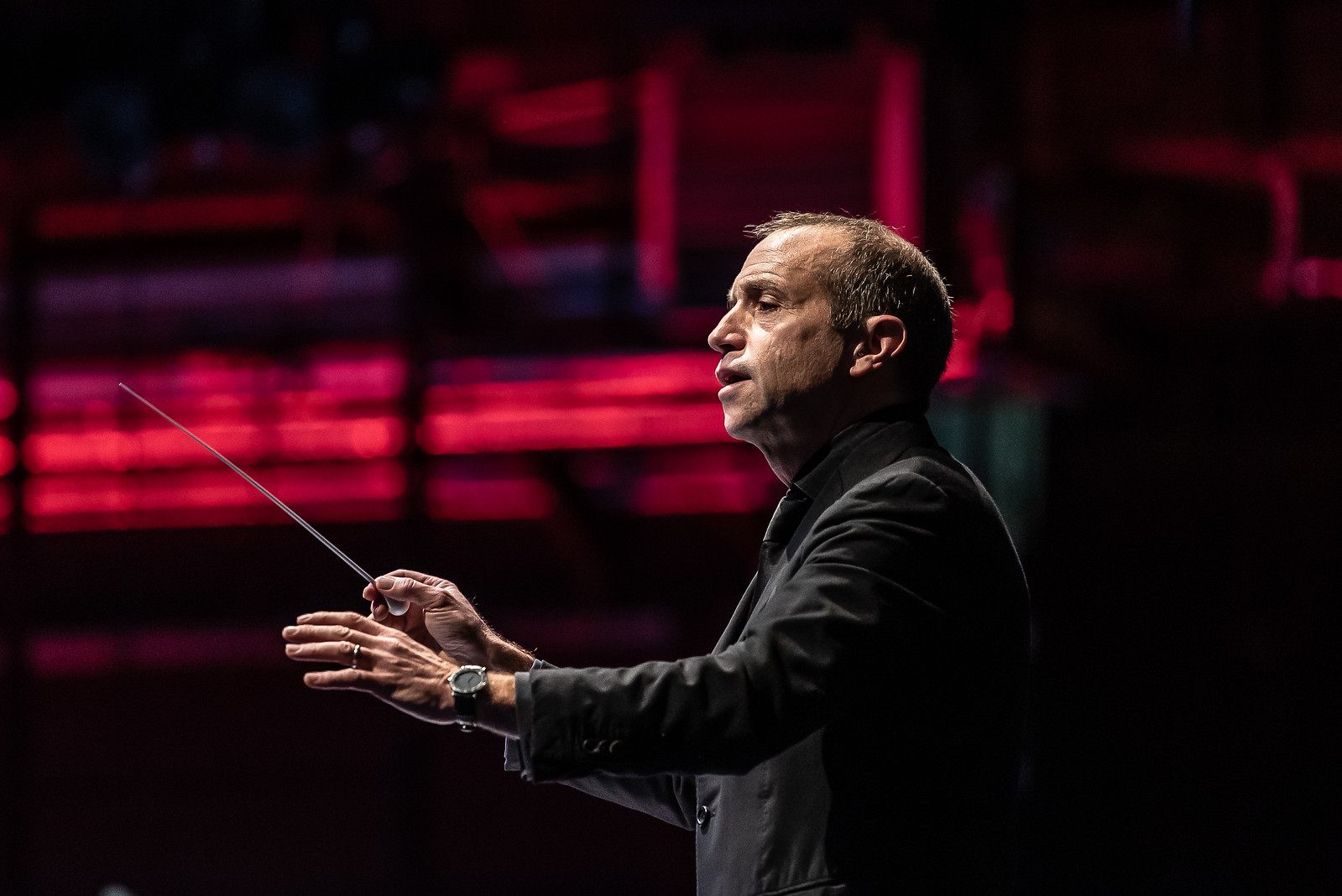Mozart's Requiem, English National Opera, BBC Two review - strong and direct act of remembrance | reviews, news & interviews
Mozart's Requiem, English National Opera, BBC Two review - strong and direct act of remembrance
Mozart's Requiem, English National Opera, BBC Two review - strong and direct act of remembrance
Tone and focus quickly established in presentation and performance

It must have felt very strange to Mark Wigglesworth that he returned to the London Coliseum under such unanticipated circumstances.
The non-invasive BBC Two format respected the mood (peak viewing time, too - though it was up against Strictly over on One) Presenter Danielle de Niese, who last sang here in very different music (Man of La Mancha), kept it brief, respectful, ungushy, with no pushing of the legends around the dying Mozart. There was a short interview with ENO’s promising new Artistic Director Annllese Miskimmon, an explanation of why schoolchildren’s photos were on the backs of all the stalls seats – over one thousand as part of the I am Here project, making it a very different ENO “audience” from the usual down there, hope for the future – and a brief composite poem delivered by performing artist Kieron Rennie; then we were off after 10 minutes.  At least three of those soloists – soprano Elizabeth Llewellyn (pictured above), mezzo-soprano Sarah Connolly and bass-baritone Gerald Finley – made you (for which read “me”) wish it was the Verdi Requiem and not Mozart's, less than half completed at his untimely death in 1791. With an opera chorus making us very aware from the off they weren’t the usual Oxbridge graduate choir you often get in this work, frequently alongside a smaller period-instrument band, you wondered if this was the right choice.The sun-like lamps against the deep blue setting of a much-deepened stage - good lighting throughout, following in the footsteps of the Royal Opera's fine online production values - reminded one that Wigglesworth had connected superbly with a very lively audience in the revival of Simon McBurney’s Magic Flute. But time and space are at a premium right now, so that memory of the glory days had to be set aside too.
At least three of those soloists – soprano Elizabeth Llewellyn (pictured above), mezzo-soprano Sarah Connolly and bass-baritone Gerald Finley – made you (for which read “me”) wish it was the Verdi Requiem and not Mozart's, less than half completed at his untimely death in 1791. With an opera chorus making us very aware from the off they weren’t the usual Oxbridge graduate choir you often get in this work, frequently alongside a smaller period-instrument band, you wondered if this was the right choice.The sun-like lamps against the deep blue setting of a much-deepened stage - good lighting throughout, following in the footsteps of the Royal Opera's fine online production values - reminded one that Wigglesworth had connected superbly with a very lively audience in the revival of Simon McBurney’s Magic Flute. But time and space are at a premium right now, so that memory of the glory days had to be set aside too.
Come the Dies Irae, the judgment-day canvas which Mozart paints as vividly as any setter of the Requiem Mass, and any doubts were banished: what was authentic turned out to be the directness of expression. Although the chorus would have looked better without their scores, they gave a full sense of the meaning, and the soloists, hands free and living the words as the excellent camerawork told us, would have made anyone understand the general emotion in each phrase even if the specific one wasn’t given on screen (only briefly did it seem odd for a company which prides itself on singing in English to deliver a Requiem in Latin without full translation).  Vocal quartet blending was full and vivid – essentially a Mozart tenor, Ed Lyon was as strong as his colleagues commitment-wise – and the choral fugues caught fire. Wigglesworth shaped the punctuating string commentaries, rounded off the ends of movements with true mastery and conjured the special hushed atmosphere needed to set up the “Lacrymosa”, returning to it later in the Agnus Dei. First-rate sound (by veteran Mike Hatch and Floating Earth) allowed all this to tell perfectly.
Vocal quartet blending was full and vivid – essentially a Mozart tenor, Ed Lyon was as strong as his colleagues commitment-wise – and the choral fugues caught fire. Wigglesworth shaped the punctuating string commentaries, rounded off the ends of movements with true mastery and conjured the special hushed atmosphere needed to set up the “Lacrymosa”, returning to it later in the Agnus Dei. First-rate sound (by veteran Mike Hatch and Floating Earth) allowed all this to tell perfectly.
The last time chorus, orchestra and conductor performer a concert mass together was back in April 2016 for a fast and furious Brahms German Requiem. There was no unseemly haste here, but the later stages gave muscular resistance to the notion that Mozart’s amanuensis Süssmayr did a poor job in his completion. Of course there's no substitute for being there - critics hadn't been invited when performances were open to the public before the November lockdown, but I would have bought a ticket for this one, if not for the drive-in La bohème at Alexandra Palace. But given the limits of streaming, it still felt natural, inevitable and remained intensely dramatic. A dedicated job well done.
rating
Explore topics
Share this article
The future of Arts Journalism
You can stop theartsdesk.com closing!
We urgently need financing to survive. Our fundraising drive has thus far raised £49,000 but we need to reach £100,000 or we will be forced to close. Please contribute here: https://gofund.me/c3f6033d
And if you can forward this information to anyone who might assist, we’d be grateful.

Subscribe to theartsdesk.com
Thank you for continuing to read our work on theartsdesk.com. For unlimited access to every article in its entirety, including our archive of more than 15,000 pieces, we're asking for £5 per month or £40 per year. We feel it's a very good deal, and hope you do too.
To take a subscription now simply click here.
And if you're looking for that extra gift for a friend or family member, why not treat them to a theartsdesk.com gift subscription?
more Classical music
 From Historical to Hip-Hop, Classically Black Music Festival, Kings Place review - a cluster of impressive stars for the future
From quasi-Mozartian elegance to the gritty humour of a kitchen inspection
From Historical to Hip-Hop, Classically Black Music Festival, Kings Place review - a cluster of impressive stars for the future
From quasi-Mozartian elegance to the gritty humour of a kitchen inspection
 Shibe, LSO, Adès, Barbican review - gaudy and glorious new music alongside serene Sibelius
Adès’s passion makes persuasive case for the music he loves, both new and old
Shibe, LSO, Adès, Barbican review - gaudy and glorious new music alongside serene Sibelius
Adès’s passion makes persuasive case for the music he loves, both new and old
 Anja Mittermüller, Richard Fu, Wigmore Hall review - a glorious hall debut
The Austrian mezzo shines - at the age of 22
Anja Mittermüller, Richard Fu, Wigmore Hall review - a glorious hall debut
The Austrian mezzo shines - at the age of 22
 First Person: clarinettist Oliver Pashley on the new horizons of The Hermes Experiment's latest album
Compositions by members of this unusual quartet feature for the first time
First Person: clarinettist Oliver Pashley on the new horizons of The Hermes Experiment's latest album
Compositions by members of this unusual quartet feature for the first time
 Gesualdo Passione, Les Arts Florissants, Amala Dior Company, Barbican review - inspired collaboration excavates the music's humanity
At times it was like watching an anarchic religious procession
Gesualdo Passione, Les Arts Florissants, Amala Dior Company, Barbican review - inspired collaboration excavates the music's humanity
At times it was like watching an anarchic religious procession
 Classical CDs: Camels, concrete and cabaret
An influential American composer's 90th birthday box, plus British piano concertos and a father-and-son duo
Classical CDs: Camels, concrete and cabaret
An influential American composer's 90th birthday box, plus British piano concertos and a father-and-son duo
 Cockerham, Manchester Camerata, Sheen, Martin Harris Centre, Manchester review - re-enacting the dawn of modernism
Two UK premieres added to three miniatures from a seminal event of January 1914
Cockerham, Manchester Camerata, Sheen, Martin Harris Centre, Manchester review - re-enacting the dawn of modernism
Two UK premieres added to three miniatures from a seminal event of January 1914
 Kempf, Brno Philharmonic, Davies, Bridgewater Hall, Manchester review - European tradition meets American jazz
Bouncing Czechs enjoy their Gershwin and Brubeck alongside Janáček and Dvořák
Kempf, Brno Philharmonic, Davies, Bridgewater Hall, Manchester review - European tradition meets American jazz
Bouncing Czechs enjoy their Gershwin and Brubeck alongside Janáček and Dvořák
 Solomon, OAE, Butt, QEH review - daft Biblical whitewashing with great choruses
Even a top soprano and mezzo can’t make this Handel paean wholly convincing
Solomon, OAE, Butt, QEH review - daft Biblical whitewashing with great choruses
Even a top soprano and mezzo can’t make this Handel paean wholly convincing
 Two-Piano Gala, Kings Place review - shining constellations
London Piano Festival curators and illustrious friends entertain and enlighten
Two-Piano Gala, Kings Place review - shining constellations
London Piano Festival curators and illustrious friends entertain and enlighten
 Echo Vocal Ensemble, Latto, Union Chapel review - eclectic choral programme garlanded with dance
Beautiful singing at the heart of an imaginative and stylistically varied concert
Echo Vocal Ensemble, Latto, Union Chapel review - eclectic choral programme garlanded with dance
Beautiful singing at the heart of an imaginative and stylistically varied concert
 Scott, Irish Baroque Orchestra, Whelan, RIAM, Dublin review - towards a Mozart masterpiece
Characteristic joy and enlightenment from this team, but a valveless horn brings problems
Scott, Irish Baroque Orchestra, Whelan, RIAM, Dublin review - towards a Mozart masterpiece
Characteristic joy and enlightenment from this team, but a valveless horn brings problems

Add comment